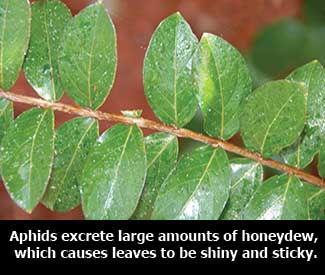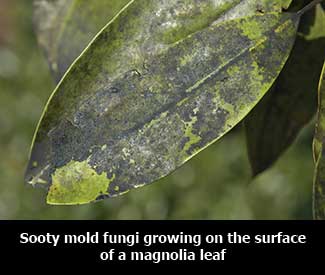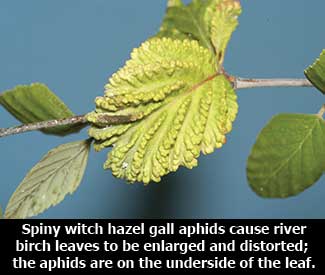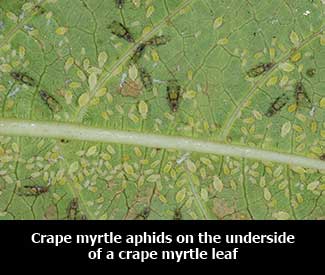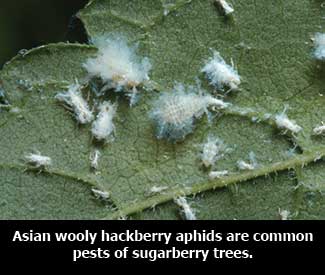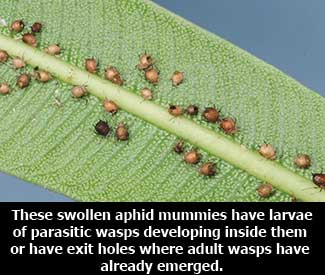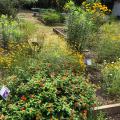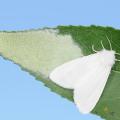Aphids
Aphids are small, pear-shaped insects with piercing-sucking mouthparts. Feeding damage can weaken plants due to the loss of sap and cause distorted growth. Infestations also cause plants to be unsightly because aphids produce large amounts of honeydew, which supports the growth of sooty mold fungi. Additionally, some species, like spiny witch hazel gall aphids, cause leaf galls, as seen here on river birch. There are many different species of aphids and most ornamental plants are fed upon by one or more species. Crape myrtle aphids occur only on crape myrtles. Oleander aphids occur on oleander but are most often seen on milkweed plants growing in butterfly gardens. Some species of aphids are covered with white, waxy material as seen on these Asian wool hackberry aphids. Adult aphids may be winged or wingless, and the nymphs look similar to wingless adults. Aphids reproduce rapidly and can quickly develop to high populations. Fortunately, there are many naturally-occurring biological control agents, including fungal diseases, predators such as lacewings and lady beetles, and parasitic wasps that help keep aphid populations in check.
Control Aphids: In many cases, aphid populations often “crash” on their own due to naturally-occurring biological control. Such population crashes often happen about the time gardeners decide “I’ve just got to do something about those aphids,” but in some cases, the population crash does not happen soon enough to prevent excessive plant damage. Consider treating if aphids are causing obvious growth distortion on young plants or if there is significant honeydew accumulation and the aphid population appears to be growing. Aphids can be quickly controlled by spraying with products containing malathion or acephate (Bonide Systemic Insect Control), but aphid infestations sometimes resurge following foliar spray treatments. Soil-applied systemic insecticides, like imidacloprid (Bonide, Ferti-lome, Monterey, BioAdvance, and others) are slower acting but usually give longer lasting control. Soil-applied systemic treatments are useful for controlling crape myrtle aphids on trees that are prone to heavy aphid outbreaks (some varieties of crape myrtle are more susceptible to aphids than others).
See Insect Pests of ornamental plants in the home landscape, page 5 and pages 39-41 for more information on aphids.
Publications
News
A grant from Coast Electric will allow for a renovation of the Mississippi State University Crosby Arboretum’s pollinator garden. Pat Drackett, director of the arboretum, said the pollinator garden was established in 2001 as the Explorers’ Garden. It is a 3,000-square-foot space with a variety of native and other plants that helps teach visitors how to create havens for pollinators.
The 2020 Fall Flower & Garden Fest will be a virtual, educational event this year.
A tent for camping in the woods can be a good thing, but a tent filled with caterpillars in a pecan tree can be bad news for homeowners.


